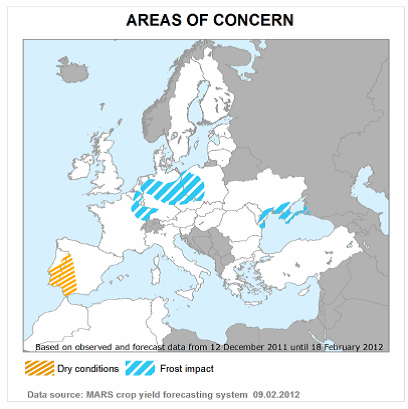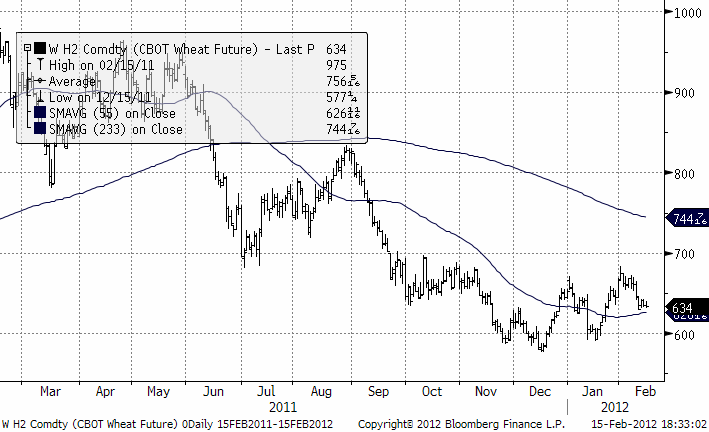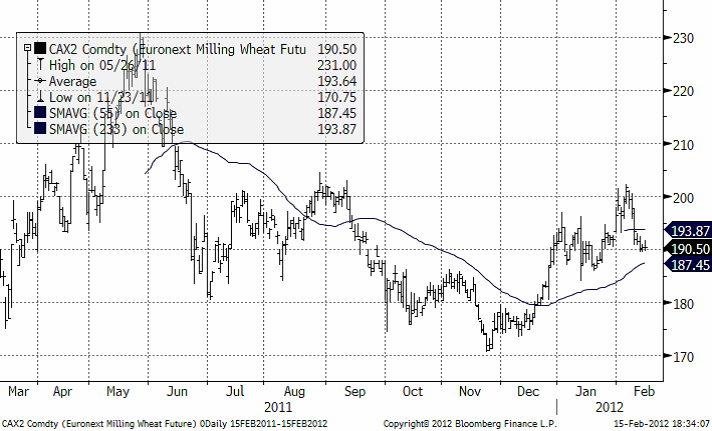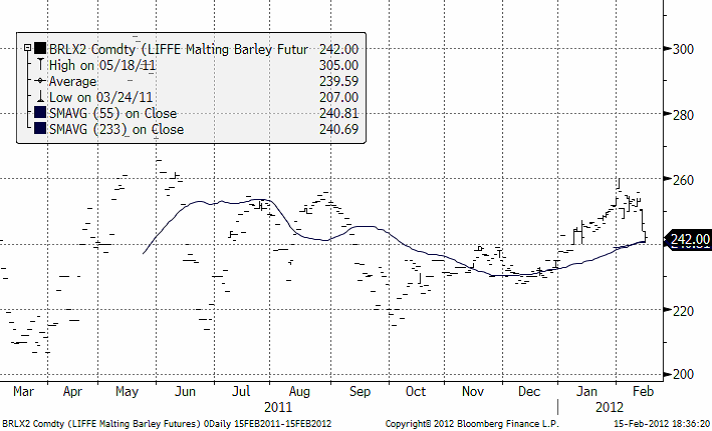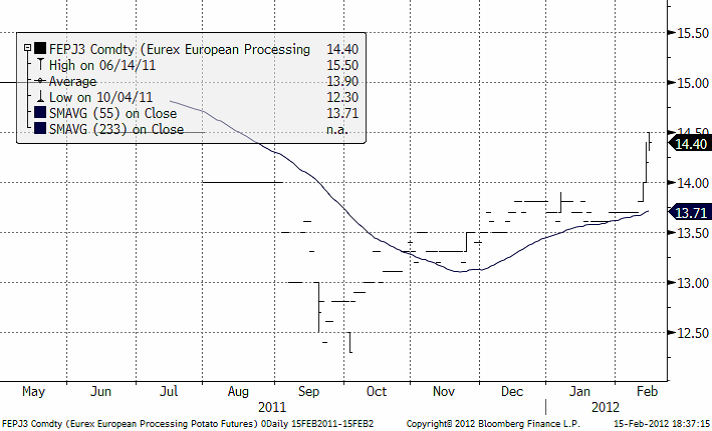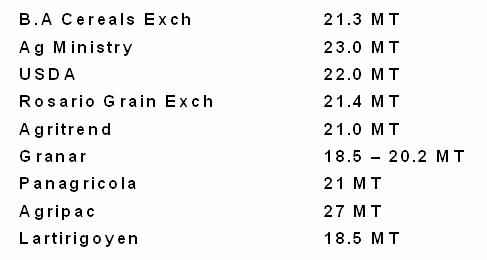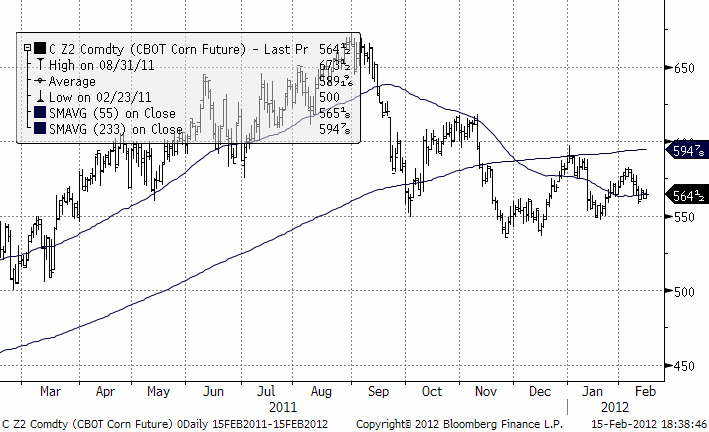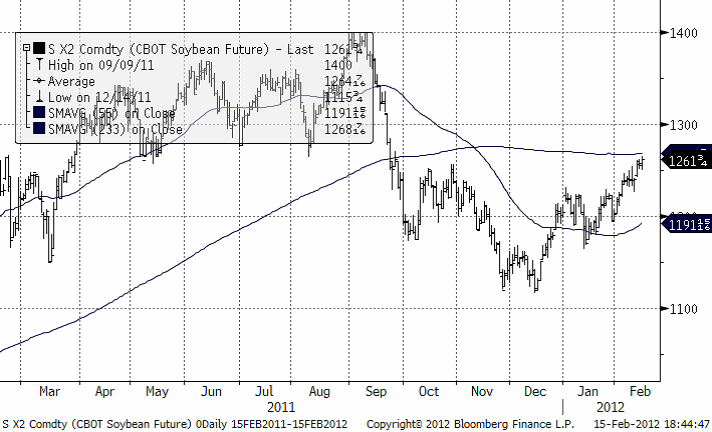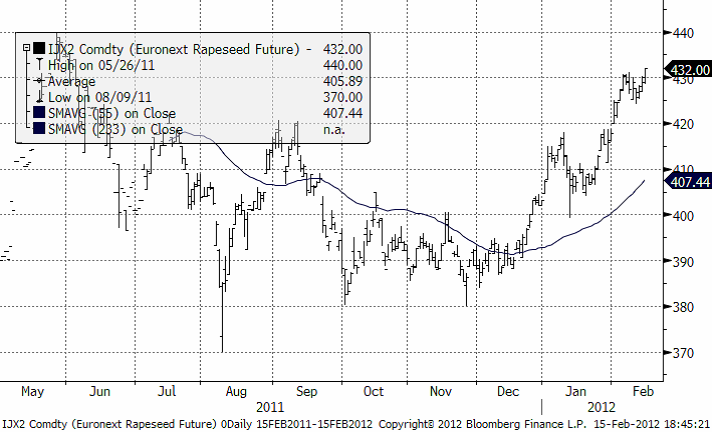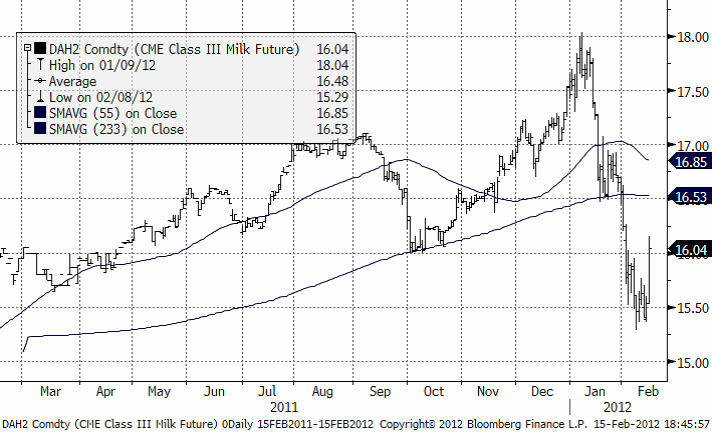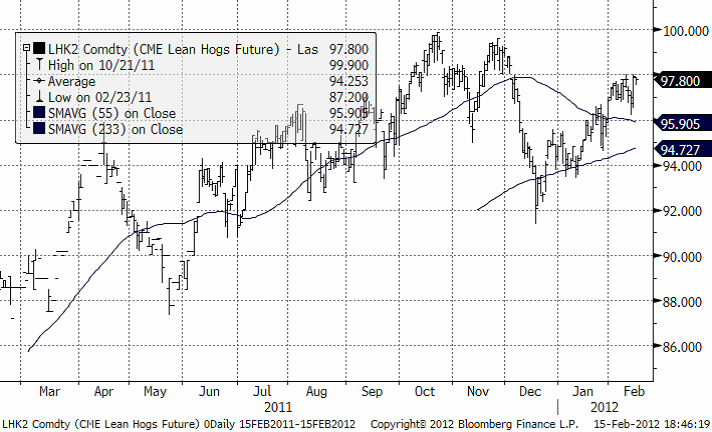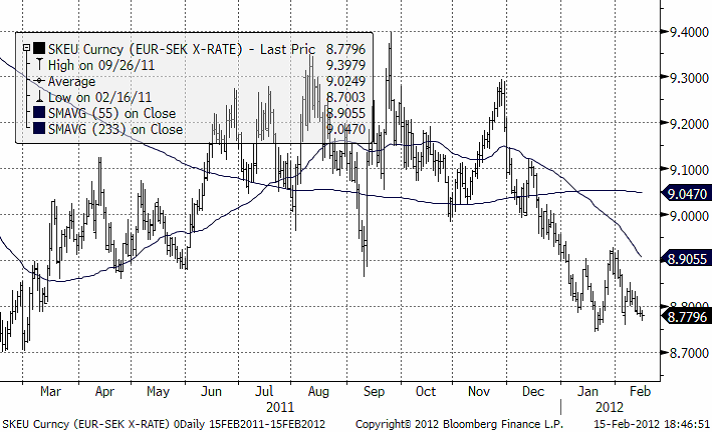Analys
SEB – Jordbruksprodukter, vecka 7 2012
 Förra veckans WASDE rapport fick samtliga jordbruksprodukter att falla i pris men fortfarande kvarstår viss oro över det torra, varma vädret i delar av Sydamerika och det kalla vädret i Europa. MARS skriver i sin februari-rapport att den hittills milda vintern delvis har gjort grödorna mindre vinterhärdiga samtidigt som de har varit utsatta för köld och frost i västra Europa men även i västra Polen, Tjeckien och runt Svarta havet och att sannolikheten är stor att det kommer att leda till köld och uttorkningsskador.
Förra veckans WASDE rapport fick samtliga jordbruksprodukter att falla i pris men fortfarande kvarstår viss oro över det torra, varma vädret i delar av Sydamerika och det kalla vädret i Europa. MARS skriver i sin februari-rapport att den hittills milda vintern delvis har gjort grödorna mindre vinterhärdiga samtidigt som de har varit utsatta för köld och frost i västra Europa men även i västra Polen, Tjeckien och runt Svarta havet och att sannolikheten är stor att det kommer att leda till köld och uttorkningsskador.
Frågetecknen kvarstår kring Grekland men trots våldsamma protester och upplopp i Aten röstade det grekiska parlamentet, med röstsiffrorna 199 mot 74, igenom det nya besparingspaketet sent i söndags. Förslaget, som nu är lag, omfattar budgetåtstramningar på 3.3 mdr eur och innehåller bland annat sänkta pensioner och minimilöner och att man tar bort 150 000 statliga jobb fram till 2015. Förutom ett parlamentariskt godkännande kräver trojkan också att ledarna för de två största politiska partierna skriftligt ska lova att de kommer att följa förslaget efter det nyval som väntas hållas inom två månader.
Kreditvärderingsföretagen har haft fullt upp. S&P sänkte under fredagen kreditbetygen för 34 italienska banker (som en följd av att Italiens kreditbetyg sänktes i januari) för att sedan på måndagen också sänka kreditbetyget för 15 spanska banker, bla storbanken Santander. Moody´s sänkte under natten till tisdagen kreditbyten för sex europeiska länder (Spanien, Italien, Portugal, Malta, Slovakien och Slovenien) medan utsikterna för Storbritannien, Frankrike och Österrike sänktes från stabila till negativa.
Vete
Vetepriset föll tillbaka kraftigt efter förra veckans WASDE rapport och har sedan dess rört sig mest sidledes.
Dagen innan USDA kom med sin WASDE rapport i förra veckan kom också FAO med sin rapport där den globala produktionen av spannmål under 2011 förväntas vara mer än tillräcklig för att tillgodose den förväntade konsumtionen under 2011/12. Ett större utbud resulterade i sjunkande priser under andra halvan av 2011 men priserna återhämtade sig i januari, vilket huvudsakligen återspeglar en oro över vädrets påverkan av 2012 års kommande skördar i flera stora spannmålsproducerande regioner.
 FAO höjer sin prognos för 2011 års globala spannmålsproduktion med 4,6 mt till 2 327 mt jämfört med sin december rapport, vilket skulle vara en ökning med 3.6 procent från 2010 och ett nytt rekord. Mycket av ökningen tillskrivs ”coarse grains” (där bl.a majs och korn ingår), där produktionen sannolikt kommer att öka med 2,3 procent till nästan 1 152 mt, vilket är 4 miljoner mer än vad som rapporterades i december. Efter årets slut så har prognosen för den globala veteproduktionen för 2011 fastställts till 694,5 mt, ett nytt rekord och en ökning med 6.3 procent jämfört med 2010.
FAO höjer sin prognos för 2011 års globala spannmålsproduktion med 4,6 mt till 2 327 mt jämfört med sin december rapport, vilket skulle vara en ökning med 3.6 procent från 2010 och ett nytt rekord. Mycket av ökningen tillskrivs ”coarse grains” (där bl.a majs och korn ingår), där produktionen sannolikt kommer att öka med 2,3 procent till nästan 1 152 mt, vilket är 4 miljoner mer än vad som rapporterades i december. Efter årets slut så har prognosen för den globala veteproduktionen för 2011 fastställts till 694,5 mt, ett nytt rekord och en ökning med 6.3 procent jämfört med 2010.
Prognosen för den globala konsumtionen av spannmål under 2011/12 justerats ned något sedan föregående rapport till 2 309 mt, vilket fortfarande är 1,8 procent högre än 2010/11. Konsumtionen av vete förväntas dock öka, och den viktigaste faktorn bakom denna tillväxt är den förväntade expansionen av vete som foder till följd av det kraftiga globala utbudet och konkurrenskraftiga priser på vetet i förhållande till majs. Konsumtionen av majs väntas däremot bara öka marginellt då efterfrågan som foderingrediens förväntas avta (och ersättas med vete) samtidigt som den industriella användningen också ökar i långsammare takt än tidigare, främst pga en stagnerande majsbaserad etanolproduktion.
Baserat på de senaste prognoserna för spannmålsproduktion under 2011 och spannmålskonsumtion under 2011/12 har FAO:s prognos för globala utgående lager i slutet av säsongen höjts med 5 mt till 516 mt. Globala utgående lager för vete förväntas öka med 29 procent, långt över det 10-åriga genomsnittet. Däremot förväntas utgående lager för t.ex majs att minska kraftigt, framför allt i USA.
Egyptens GASC köpte 55 000 ton vete från USA i helgen vilket är första gången som Egypten köper vete från USA denna säsong. Det visar dock på att det amerikanska vetet nu är konkurrenskraftigt i prissättningen i jämförelse med Ryssland och Frankrike som gick lottlösa denna gång.
Nedan ser vi terminspriset på Chicago-vete (mars) som föll tillbaka efter WASDE-rapporten men som därefter har handlats i intervallet 630 – 640 USc.
Det verkar som att Ukrainas jordbruksminister har bett spannmålshandlare som verkar på den inhemska marknaden att vara restriktiva i sin export av vete då torkan som drabbade landet i höstas samt det nuvarande kalla vädret i kombination med brist på snötäcke i vissa delar kommer att påverka årets veteskörd. Handelshusen uppmanas att noggrant följa den inhemska vetemarknadens utbud och efterfrågan och att inte prioriterade vete i spannmål för export. Korn och majs berörs dock inte av detta. Regeringen vill också undvika ett eventuellt införande av exportrestriktioner och förhoppningen är att en återhållsammare export tillgodoser detta.
Ukrainas spannmålsexport har varit fri från restriktioner i ungefär en och en halv månad nu.
Beskattningen på export av korn gällde från förra sommaren fram till den 31 dec 2011, medan exportskatten på vete och majs gällde från sommaren och fram till oktober 2011. Dessförinnan var landets spannmålsexport begränsad av kvoter under 7 månader efter torkan sommaren 2010.
Australiensiska ABARES adderar ytterligare 700 000 ton i sin prognos för landets export av vete 2011/12, som nu uppgår till 22,3 mt, efter att ha justerat upp Australiens veteskörd med 1.23 mt till en rekordnivå på 29.5 mt. ABARES prognos över exportsiffrorna ligger över USDA estimat på 21 mt i förra veckans WASDE rapport och om siffrorna stämmer kommer Australien att hamna på andra plats i världsrankingen, före både Europa och Ryssland.
Veteproduktionen i Indien för 2011/12 förväntas uppgå till 88,31 mt, vilket är ett nytt rekord, samtidigt som de statliga lagren uppgick till 25,7 mt per den 1 januari vilket är 3 gånger mer än det officiella målet för nuvarande kvartal. Indiens egen konsumtion av vete uppgår till ca 76 mt vilket skulle ge möjlighet att exportera överskottet.
Iran har vänt sig till Indien för köp av vete då andra säljare är avvaktande pga sanktionsrelaterade problem med betalningar för bl.a europeiskt spannmål och som nu också har stoppats landets import av palmolja. Iran har en växande lista över livsmedel som importeras och som nu påverkas av USA’s och EU’s sanktioner som syftar till att tvinga Teheran att skrota ett misstänkt kärnvapenprogram. Iran importerar ca 4,5 mt spannmål per år, varav ca 3,5 mt majs som framförallt används till djurfoder. Enligt USDA förlitar sig landet på import för att möta mer än 60 procents av sitt behov av majs men endast 3 procent av sitt behov av vete. Vete kan dock användas för att ersätta majs som djurfoder, vilket skulle kunna vara förklaringen att Iran vänt sig till Indien med en förfrågan, särskilt efter att nyheten att importen av majs från Ukraina har halverats.
Nedan ser vi terminspriset på Matif-vete (november) .
Maltkorn
Nedan ser vi terminskontraktet för maltkorn med novemberleverans på Matif.
Potatis
Nedan ser vi kursdiagrammet på europeisk potatis, som handlas på Eurex; terminen avser leverans april 2013.
Majs
Argentinas majsproduktion drabbades hårt av torkan under december och januari och Buenos Aires Cereals Exchange sänkte sin prognos för produktionen av majs 2011/12 till 21,3 mt, en minskning från 22 mt veckan innan. I början av säsongen förväntades majs produktionen att uppgå till 30 mt men varmt och torrt väder har drabbat grödorna hårt. Majs som såddes i början av säsongen drabbades värst av torkan under dess viktigaste tillväxtfas, men en del av det bortfallet kommer att kompenseras av högre avkastning i de norra delarna där sådden skedde senare och grödorna fick tillräckligt med regn. Argentina är världens näst största exportör av majs efter USA och oron över torkan som drabbat landet har drivit upp priserna.
Nedan är estimat för Argentinas majs produktion 2011/12
Som vi skrev i förra veckans brev så ser man ovan att så USDA´s 22 mt ligger högt i intervallet av prognoser medan inhemska Argentinska prognosmakare mer ligger i intervallet 18 – 22 mt. Produktionen skulle alltså ha kunnat minska med 8 mt istället för de 4 mt som USDA förutspår nu i sin februari rapport.
Det torra vädret har också påverkat grödorna i Sydafrika och Mexiko. USDA justerar ned majsskörden i Sydafrika med mer än 400 000 ton till följd av torra väderförhållanden och Mexikos majsskörd förväntas hamna på ett 11-års lägsta om 18,4 mt då landet har genomlidit den värsta torkan på flera årtionden.
Nedan ser vi terminskontraktet på Chicago för majs (december).
Ukrainas majs export till Iran sjönk med 40 procent förra månaden till följd av sanktioner från EU som orsakar försenade eller uteblivna betalningar från iranska köpare. Förhandlingar förs dock mellan de två länderna för att undvika konflikter eftersom Iran utgör en viktig marknad för Ukraina och Ukraina i sin tur utgör Irans viktigaste leverantör av majs tillsammans med Brasilien och Argentina.
Sojabönor
Priset på sojabönor fick sig också en törn efter WASD rapporten men har sedan dess fortsatt uppåt igen då oron över det torra vädret i södra Brasilien kvarstår.
Baserat på lägre Sydamerikanska skördar justerar USDA ner den globala sojabönsproduktionen för 2011/12 med 5,5 mt till 251,5 mt (jämfört med 264.2 mt 2010/11). Man hade tidigare räknat med att produktionen i Sydamerika delvis skulle kompensera minskningen i den amerikanska produktionen, men detta verkar nu osannolikt. Som en följd av lägre produktion väntas de globala utgående lagren minska med 13 procent i år till 60.3 mt.
Brasiliens produktion justeras ned med 2 mt till 72 mt. En stor del av minskningen beror på bortfall i den södra delstaten Parana. Regionen har i stort sett endast fått hälften av den normala säsongsmässiga nederbörden. Längre söderut, i Rio Grande Do Sul, har sådden skett senare men grödorna är nu i stort behov av regn. Trots problemen med produktionen i de södra regionerna, har Brasilien fortfarande möjlighet att få sin näst största skörd någonsin i år till följd av ökad areal och gynnsamma växtförhållanden i andra delar av landet. Skörden i Mato Grosso har avstannat något pga ihållande regnväder och således är endast 6 procent av landets sojabönsskörd avklarad.
På andra sidan gränsen, i Paraguay, har vädret varit lika torrt som i Parana med väldigt lite regn sedan början på december. Minskad areal och kraftigt minskad avkastning gör att estimatet för Paraguays sojabönsskörd krymper till 6,4 mt i år, jämfört med förra månadens prognos på 7,6 mt och förra årets rekordskörd på 8,3 mt.
Nedan ser vi terminspriset på Chicago för sojabönor (november).
Nederbörden i december i centrala Argentina visar på historiskt låg mängd för månaden och torkan förvärrades också av intensiv värme. Sedan mitten av januari har dock nederbördsmängden förbättrats något, vilket har stabiliserat växtförhållandena och uppmuntrat till fortsatt sådd. Den argentinska regeringen rapporterade att sådden av sojabönor per den 2 februari uppgick till 18,5 miljoner hektar och det kommer troligtvis inte att ske någon större förändring gällande den siffran då man är i slutet av den tidsperiod då sådd är möjlig. Det är nu väsentligt att landet får tillräckligt med nederbörd. Om regnet fortsätter (liksom förra året då regnet kom efter en tidig torrperiod) kan avkastningen fortfarande ligga nära genomsnittet, å andra sidan skulle det också kunna vara möjligt att avkastningen minskar dramatiskt om torkan fortsätter att hålla i sig. Prognosen för Argentinas produktion har justerats ned 2,5 mt till 48 mt.
Även om Uruguays produktion av sojabönor hamnar i skuggan jämfört med sina större grannar har den expanderat snabbt under det senaste det senaste decenniet och arealen för i år uppskattas till rekordhöga 1 miljon hektar. Men det torra och varma vädret har också drabbat Uruguay och estimatet för årets produktion justeras ned 100 000 ton till 1,7 miljoner ton. Nästan allt går till export.
Lägre utbud och stigande priser på sojabönor kommer sannolikt att bromsa den globala importen av sojabönor. Kina som står för ca 60 procent av den globala handeln med sojabönor har under perioden oktober 2011 till januari 2012 importerat ca 19,5 mt, en liten nedjustering från 19,8 mt året innan.
Raps
Priset på raps har fortsatt uppåt sedan förra veckan och får support av ett begränsat utbud samt prisuppgången på sojabönor på CBOT och en fortsatt uppgång I priset på råolja.
Oil World har justerat ned sina estimat för raps produktionen i Ukraina till 1.05 mt för 2012 jämfört med 1.38 mt förra året.
Även om Indien kommer att få en rekordskörd av vete i år så ser det värre ut för rapsproduktionen som sannolikt kommer att minska med en fjärdedel, vilket innebär att landets import av vegetabiliska oljor kan komma att öka kraftigt. Den förväntade minskningen av raps speglar sannolikt en krympande produktion i Rajasthan, den indiska delstaten i norr som står för ungefär hälften av landets raps produktion till följd av minskad areal, torrt väder under sådden i oktober och att lantbrukare föredrar att så kikärtor istället.
Förra årets rekordskörd av kanadensisk canola (raps) håller på att försvinna snabbt och beror i första hand på en stark exportefterfrågan. Exporten för 2011/12 beräknas uppgå till rekordhöga 8 mt, en ökning med 800 000 ton från förra månadens prognos, och där Kina står för en majoritet av ökningen med en estimerad import på 1,4 mt. Även Kinas import av rapsmjöl från Canada kan komma att öka då Kina nyligen har förbjudit import av rapsmjöl från Indien till följd av att man upptäckt laster med rapsmjöl som innehållit färgämnen (malakitgrönt) som används för att märka spannmålssäckar.
Enligt ABARES förväntas Australiens canola produktion uppgå till 2,78 mt, en ökning med 280 000 ton mot tidigare estimat, och tillräckligt för en export av ca 2 mt (mot tidigare 1.88 mt).
Nedan ser vi terminskontraktet på Matif för raps (november) som fortfarande håller ett högt pris ur ett historiskt perspektiv och är säljvärt, tror vi.
Mjölk
Nedan ser vi priset på marskontraktet på flytande mjölk (kontakt avräknat mot USDA:s prisindex). Priset har som vi ser fallit kraftigt i februari.
Gris
Priset på lean hogs har segat sig uppåt och befinner sig nu återigen i sälj-området. Nedan ser vi terminspriset för leverans i maj.
Valutor
EURSEK
Vi har en neutral rekommendation på både en veckas sikt och tre månaders.
EURUSD
Rekommendation: Neutral på en veckas sikt. Negativ på tre månader.
USDSEK
Vi har en neutral rekommendation på en veckas sikt, men är positiva på tre månader.
[box]SEB Veckobrev Jordbruksprodukter är producerat av SEB Merchant Banking och publiceras i samarbete och med tillstånd på Råvarumarknaden.se[/box]
Disclaimer
The information in this document has been compiled by SEB Merchant Banking, a division within Skandinaviska Enskilda Banken AB (publ) (“SEB”).
Opinions contained in this report represent the bank’s present opinion only and are subject to change without notice. All information contained in this report has been compiled in good faith from sources believed to be reliable. However, no representation or warranty, expressed or implied, is made with respect to the completeness or accuracy of its contents and the information is not to be relied upon as authoritative. Anyone considering taking actions based upon the content of this document is urged to base his or her investment decisions upon such investigations as he or she deems necessary. This document is being provided as information only, and no specific actions are being solicited as a result of it; to the extent permitted by law, no liability whatsoever is accepted for any direct or consequential loss arising from use of this document or its contents.
About SEB
SEB is a public company incorporated in Stockholm, Sweden, with limited liability. It is a participant at major Nordic and other European Regulated Markets and Multilateral Trading Facilities (as well as some non-European equivalent markets) for trading in financial instruments, such as markets operated by NASDAQ OMX, NYSE Euronext, London Stock Exchange, Deutsche Börse, Swiss Exchanges, Turquoise and Chi-X. SEB is authorized and regulated by Finansinspektionen in Sweden; it is authorized and subject to limited regulation by the Financial Services Authority for the conduct of designated investment business in the UK, and is subject to the provisions of relevant regulators in all other jurisdictions where SEB conducts operations. SEB Merchant Banking. All rights reserved.
Analys
Tightening fundamentals – bullish inventories from DOE

The latest weekly report from the US DOE showed a substantial drawdown across key petroleum categories, adding more upside potential to the fundamental picture.

Commercial crude inventories (excl. SPR) fell by 5.8 million barrels, bringing total inventories down to 415.1 million barrels. Now sitting 11% below the five-year seasonal norm and placed in the lowest 2015-2022 range (see picture below).
Product inventories also tightened further last week. Gasoline inventories declined by 2.1 million barrels, with reductions seen in both finished gasoline and blending components. Current gasoline levels are about 3% below the five-year average for this time of year.
Among products, the most notable move came in diesel, where inventories dropped by almost 4.1 million barrels, deepening the deficit to around 20% below seasonal norms – continuing to underscore the persistent supply tightness in diesel markets.
The only area of inventory growth was in propane/propylene, which posted a significant 5.1-million-barrel build and now stands 9% above the five-year average.
Total commercial petroleum inventories (crude plus refined products) declined by 4.2 million barrels on the week, reinforcing the overall tightening of US crude and products.


Analys
Bombs to ”ceasefire” in hours – Brent below $70

A classic case of “buy the rumor, sell the news” played out in oil markets, as Brent crude has dropped sharply – down nearly USD 10 per barrel since yesterday evening – following Iran’s retaliatory strike on a U.S. air base in Qatar. The immediate reaction was: “That was it?” The strike followed a carefully calibrated, non-escalatory playbook, avoiding direct threats to energy infrastructure or disruption of shipping through the Strait of Hormuz – thus calming worst-case fears.

After Monday morning’s sharp spike to USD 81.4 per barrel, triggered by the U.S. bombing of Iranian nuclear facilities, oil prices drifted sideways in anticipation of a potential Iranian response. That response came with advance warning and caused limited physical damage. Early this morning, both the U.S. President and Iranian state media announced a ceasefire, effectively placing a lid on the immediate conflict risk – at least for now.
As a result, Brent crude has now fallen by a total of USD 12 from Monday’s peak, currently trading around USD 69 per barrel.
Looking beyond geopolitics, the market will now shift its focus to the upcoming OPEC+ meeting in early July. Saudi Arabia’s decision to increase output earlier this year – despite falling prices – has drawn renewed attention considering recent developments. Some suggest this was a response to U.S. pressure to offset potential Iranian supply losses.
However, consensus is that the move was driven more by internal OPEC+ dynamics. After years of curbing production to support prices, Riyadh had grown frustrated with quota-busting by several members (notably Kazakhstan). With Saudi Arabia cutting up to 2 million barrels per day – roughly 2% of global supply – returns were diminishing, and the risk of losing market share was rising. The production increase is widely seen as an effort to reassert leadership and restore discipline within the group.
That said, the FT recently stated that, the Saudis remain wary of past missteps. In 2018, Riyadh ramped up output at Trump’s request ahead of Iran sanctions, only to see prices collapse when the U.S. granted broad waivers – triggering oversupply. Officials have reportedly made it clear they don’t intend to repeat that mistake.
The recent visit by President Trump to Saudi Arabia, which included agreements on AI, defense, and nuclear cooperation, suggests a broader strategic alignment. This has fueled speculation about a quiet “pump-for-politics” deal behind recent production moves.
Looking ahead, oil prices have now retraced the entire rally sparked by the June 13 Israel–Iran escalation. This retreat provides more political and policy space for both the U.S. and Saudi Arabia. Specifically, it makes it easier for Riyadh to scale back its three recent production hikes of 411,000 barrels each, potentially returning to more moderate increases of 137,000 barrels for August and September.
In short: with no major loss of Iranian supply to the market, OPEC+ – led by Saudi Arabia – no longer needs to compensate for a disruption that hasn’t materialized, especially not to please the U.S. at the cost of its own market strategy. As the Saudis themselves have signaled, they are unlikely to repeat previous mistakes.
Conclusion: With Brent now in the high USD 60s, buying oil looks fundamentally justified. The geopolitical premium has deflated, but tensions between Israel and Iran remain unresolved – and the risk of missteps and renewed escalation still lingers. In fact, even this morning, reports have emerged of renewed missile fire despite the declared “truce.” The path forward may be calmer – but it is far from stable.
Analys
A muted price reaction. Market looks relaxed, but it is still on edge waiting for what Iran will do

Brent crossed the 80-line this morning but quickly fell back assigning limited probability for Iran choosing to close the Strait of Hormuz. Brent traded in a range of USD 70.56 – 79.04/b last week as the market fluctuated between ”Iran wants a deal” and ”US is about to attack Iran”. At the end of the week though, Donald Trump managed to convince markets (and probably also Iran) that he would make a decision within two weeks. I.e. no imminent attack. Previously when when he has talked about ”making a decision within two weeks” he has often ended up doing nothing in the end. The oil market relaxed as a result and the week ended at USD 77.01/b which is just USD 6/b above the year to date average of USD 71/b.

Brent jumped to USD 81.4/b this morning, the highest since mid-January, but then quickly fell back to a current price of USD 78.2/b which is only up 1.5% versus the close on Friday. As such the market is pricing a fairly low probability that Iran will actually close the Strait of Hormuz. Probably because it will hurt Iranian oil exports as well as the global oil market.
It was however all smoke and mirrors. Deception. The US attacked Iran on Saturday. The attack involved 125 warplanes, submarines and surface warships and 14 bunker buster bombs were dropped on Iranian nuclear sites including Fordow, Natanz and Isfahan. In response the Iranian Parliament voted in support of closing the Strait of Hormuz where some 17 mb of crude and products is transported to the global market every day plus significant volumes of LNG. This is however merely an advise to the Supreme leader Ayatollah Ali Khamenei and the Supreme National Security Council which sits with the final and actual decision.
No supply of oil is lost yet. It is about the risk of Iran closing the Strait of Hormuz or not. So far not a single drop of oil supply has been lost to the global market. The price at the moment is all about the assessed risk of loss of supply. Will Iran choose to choke of the Strait of Hormuz or not? That is the big question. It would be painful for US consumers, for Donald Trump’s voter base, for the global economy but also for Iran and its population which relies on oil exports and income from selling oil out of that Strait as well. As such it is not a no-brainer choice for Iran to close the Strait for oil exports. And looking at the il price this morning it is clear that the oil market doesn’t assign a very high probability of it happening. It is however probably well within the capability of Iran to close the Strait off with rockets, mines, air-drones and possibly sea-drones. Just look at how Ukraine has been able to control and damage the Russian Black Sea fleet.
What to do about the highly enriched uranium which has gone missing? While the US and Israel can celebrate their destruction of Iranian nuclear facilities they are also scratching their heads over what to do with the lost Iranian nuclear material. Iran had 408 kg of highly enriched uranium (IAEA). Almost weapons grade. Enough for some 10 nuclear warheads. It seems to have been transported out of Fordow before the attack this weekend.
The market is still on edge. USD 80-something/b seems sensible while we wait. The oil market reaction to this weekend’s events is very muted so far. The market is still on edge awaiting what Iran will do. Because Iran will do something. But what and when? An oil price of 80-something seems like a sensible level until something do happen.
-

 Nyheter4 veckor sedan
Nyheter4 veckor sedanMahvie Minerals växlar spår – satsar fullt ut på guld
-

 Analys4 veckor sedan
Analys4 veckor sedanA muted price reaction. Market looks relaxed, but it is still on edge waiting for what Iran will do
-

 Nyheter3 veckor sedan
Nyheter3 veckor sedanJonas Lindvall är tillbaka med ett nytt oljebolag, Perthro, som ska börsnoteras
-

 Nyheter3 veckor sedan
Nyheter3 veckor sedanOljan, guldet och marknadens oroande tystnad
-

 Nyheter3 veckor sedan
Nyheter3 veckor sedanDomstolen ger klartecken till Lappland Guldprospektering
-

 Analys3 veckor sedan
Analys3 veckor sedanTightening fundamentals – bullish inventories from DOE
-

 Nyheter2 veckor sedan
Nyheter2 veckor sedanRyska staten siktar på att konfiskera en av landets största guldproducenter
-
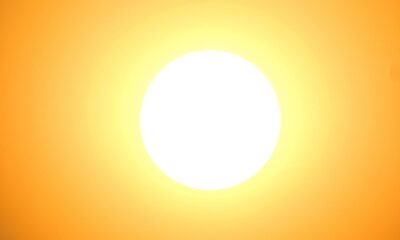
 Nyheter2 veckor sedan
Nyheter2 veckor sedanSommarvädret styr elpriset i Sverige


